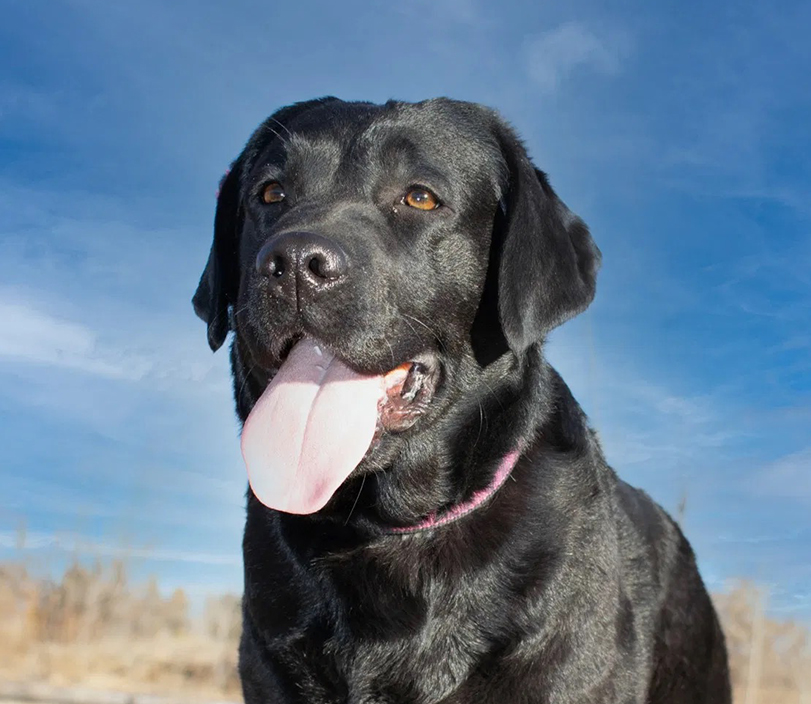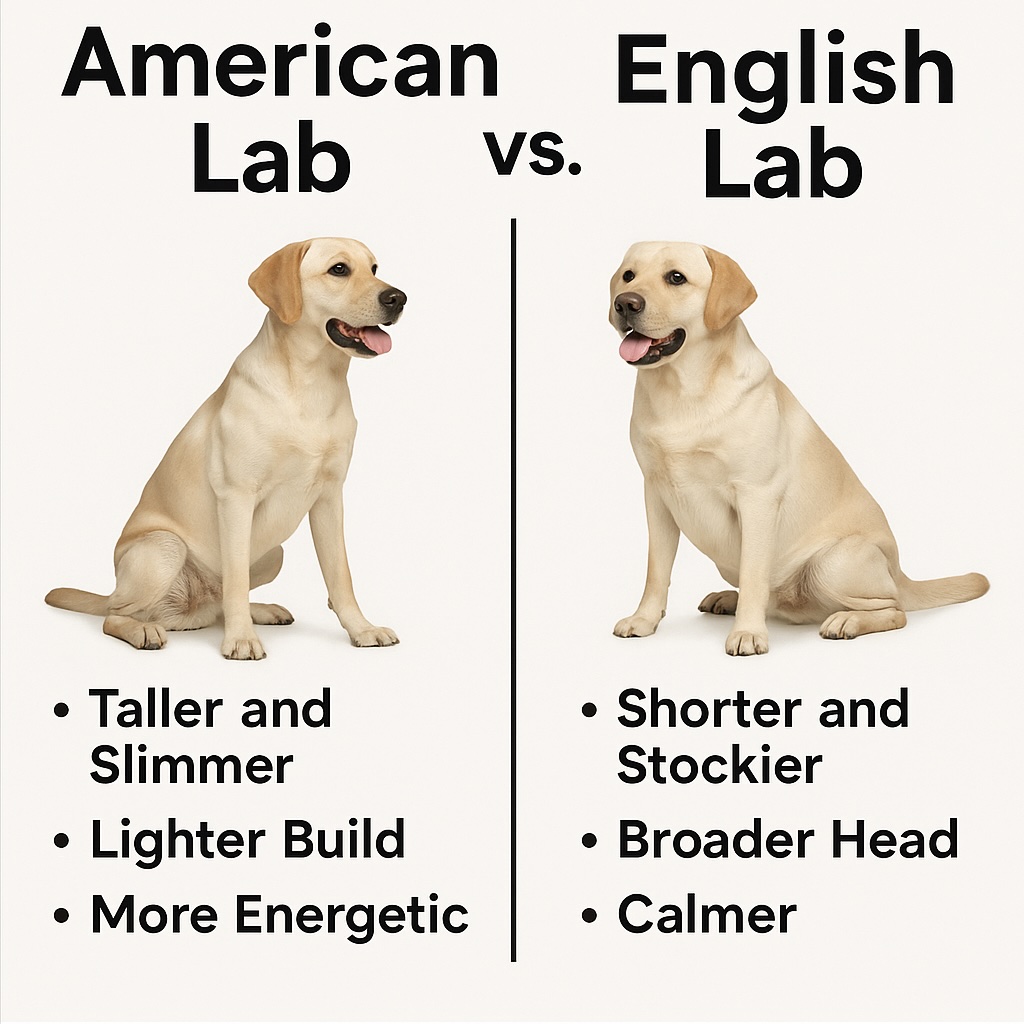English Labrador vs American Labrador: What’s the Difference?

English Labrador. American Labrador. What’s the difference, anyway?
If you’ve ever searched for Labrador puppies, you’ve probably come across two terms: English Labrador and American Labrador. But what do they really mean? Are they different breeds, or just different styles?
As a breeder who spends every day with Labradors, I’ve seen firsthand how these labels can confuse families. Let’s clear up the myths, highlight the true differences, and help you decide which Labrador might be right for your family.
Are English and American Labradors Different Breeds?
Here’s the truth: there is only one breed of Labrador Retriever.
The American Kennel Club (AKC) doesn’t officially recognize “English” and “American” as separate breeds. Instead, these terms have become shorthand for two styles of Labrador:
- English (or “show”) Labradors – generally bred for conformation shows and companionship.
- American (or “field”) Labradors – generally bred for hunting, field trials, and high-performance work.

Side-by-Side Comparison
| Feature | English Labrador 🐾 | American Labrador 🐾 |
|---|---|---|
| Build | Stocky, blocky head, heavier bone | Leaner, taller, athletic |
| Temperament | Calm, steady, affectionate | Energetic, driven, eager |
| Energy Needs | Moderate daily activity | High daily activity & stimulation |
| Ideal Family | Families, therapy work, companion homes | Hunters, runners, highly active homes |
| Coat & Grooming | Thick double coat, same as all Labs | Thick double coat, same as all Labs |

Temperament Differences
This is where families notice the biggest contrast:
- English Labs often have a calmer, gentler temperament. They love being close, thrive as family companions, and are easier to manage in everyday home life.
- American Labs are known for their endless energy and drive. They excel in field trials, agility, and high-activity households, but can feel overwhelming for families looking for a low-key pet.
Of course, every puppy is an individual. Just like people, Labradors fall along a spectrum of personality and energy. That’s why a responsible breeder pays close attention to lineage, health, and temperament — to match the right pup with the right family.
Why Families Choose English Labradors
At Kindred Pup, we specialize in English Labradors because of their:
- Gentle, steady nature — wonderful with children and other pets.
- Classic look — blocky head, soulful eyes, strong build.
- Family focus — equally happy in the backyard, on the couch, or on a hike.
Our goal is to raise Labradors who bring calm joy and lasting companionship to your home.
Just as with humans, some family trees pass on large, muscular builds while others pass on petite frames; some seem to have a natural inclination toward creativity and others toward athletics, all while being genetically human. You wouldn’t ask: “Is this human a pure bred athletic type?”
A Brief History of English and American Labradors
Though they share common ancestry, the development of English and American Labradors diverged over time. The Labrador Retriever breed itself originated from Newfoundland in the 1800s, where they were used as fishing dogs to help retrieve nets and catch fish that escaped the lines.
In the early 20th century, Labradors were introduced to England, where selective breeding began to produce the blockier, stockier Labs now known as the English type. Breeders in the U.K. focused on producing dogs that would excel in conformation shows, prioritizing their physical appearance and calm temperament.
In contrast, breeders in the United States were more interested in Labradors for their fieldwork abilities. Thus, the American Labrador emerged with a sleeker body and high-energy temperament, perfect for hunting and retrieving in wide-open spaces.
Despite these differences, both types still share the core qualities that make Labradors such amazing companions—friendliness, intelligence, and an eagerness to please.
Which Labrador is Right for You?
When deciding between an English or American Labrador, it’s essential to consider your lifestyle and what you’re looking for in a dog. Here are a few tips:
- Consider your activity level: American Labs thrive in active environments where they can use their energy. If you enjoy outdoor activities like running, hiking, or hunting, they will make an excellent companion. English Labs are more laid-back, making them perfect for homes that prefer a more relaxed dog who enjoys occasional exercise.
- Purpose: If you’re looking for a family pet or a dog for conformation shows, an English Labrador might be the way to go. If you need a working dog or a canine athlete, an American Lab’s focus and energy might be more appropriate.
- Space: American Labs are more energetic and may require more room to roam. English Labs, while still active, might be better suited for smaller homes or those with a moderate level of daily exercise.
Additional Helpful Tips
- Training and Socialization: Both types of Labradors are highly intelligent and trainable, but American Labs may require more intensive training due to their high energy. Early socialization and consistent, positive reinforcement are key to raising a well-behaved Lab.
- Grooming: Both English and American Labs have the same grooming needs, thanks to their double coat that sheds year-round. Weekly brushing will help manage shedding, and during spring and fall, when they “blow” their coats, more frequent grooming may be necessary.
- Health Considerations: Like all dogs, Labradors are prone to certain health issues. Common concerns include hip dysplasia, elbow dysplasia, and eye conditions. It’s crucial to choose a responsible breeder who tests their breeding dogs for these genetic conditions.
Conclusion
While the differences between English Labradors and American Labradors may seem significant, at the end of the day, both are wonderful representatives of the Labrador Retriever breed. Choosing between them comes down to your personal preferences, lifestyle, and what you hope to get from your dog.
Whether you opt for an English Lab’s calmer demeanor or the American Lab’s energetic spirit, you’re sure to gain a loyal, loving companion who will enrich your life for years to come.
FAQs
1. Are English Labradors healthier than American Labradors?
Since they are both genetically labradors, both types (and all colors) are prone to similar health issues, and the key to a healthy dog is responsible breeding. Look for breeders who conduct genetic testing, know the pedigrees, and understand low inbreeding coefficients, as well as some training with a reproductive vet.
2. Do English Labs need less exercise than American Labs?
While English Labs tend to be calmer, they still require daily exercise to stay healthy and keep their weight down. (In fact, the calmer the dog, the more likely it is that you will have to watch their weight closely!) American Labs may need more due to their higher energy levels.
3. Can you tell if a puppy is English Labrador or an American Labrador just by looking at them?
Puppies may show early signs of their future build, but it can be tricky to tell until they are older. Ask your breeder about the parents’ lineage to get a better idea. English Labs continue to “thicken” for 12-18 months.
By understanding the differences between these two types of Labradors, you can make an informed decision that fits your lifestyle and preferences. Whether you’re drawn to the sturdier English Labrador or the athletic American Lab, both offer loyalty, love, and endless companionship! At Kindred Pup, we can help you find an available English Labrador Puppy that is right for you!
Keywords: English Labrador vs American Labrador, Labrador Retriever differences, American Lab temperament, English Lab vs American Lab, Labrador breed guide, choosing a Labrador

Please also keep in mind that variations come in all forms of biology and reproduction, and that’s true of the English Labrador and every other living being. While the sire and dam’s appearance and temperament are the very best predictor of a pup’s future, some variation is always possible. (Ever met a quiet and shy father with an active and ambitious son?)
Knowing what we know of the breed and the different goals, we are looking to breed what we believe to be the best of both worlds. Exemplary in every way – an example of what we believe to be the best aspects of the breed. We prefer our labs to have the blocky heads, strong bodies and thick “otter” tails, but we also want to breed puppies slightly taller than their traditionally English counterparts. When I read the unofficial distinctions of these Labradors, I see things I want in a puppy from both sides. That’s why we have chosen the girls we have, and why we have made sure to use only a few very trustworthy sires.
A good breeder will know the strength of their dams, and have in mind exactly what they are aiming to breed into (or out of) their lines. Raising High-Quality English Labradors is not easy, but it is rewarding, and raising them in beautiful Tennessee is all the better.
We have a goal in mind –to produce good-tempered, beautiful and healthy English labradors in a way that is improving the gene pool. We do this by breeding well-suited dams to complimentary sires to produce the best traits possible.
Sources:
Read the AKC Breed Standards here.